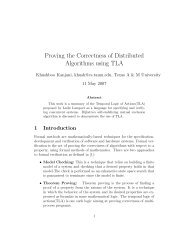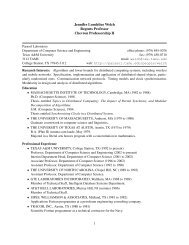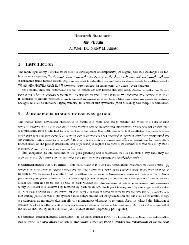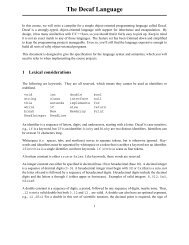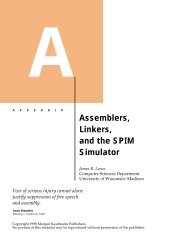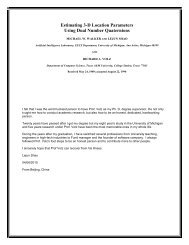Hoard: A Scalable Memory Allocator for Multithreaded Applications
Hoard: A Scalable Memory Allocator for Multithreaded Applications
Hoard: A Scalable Memory Allocator for Multithreaded Applications
You also want an ePaper? Increase the reach of your titles
YUMPU automatically turns print PDFs into web optimized ePapers that Google loves.
literature. As we demonstrate, <strong>Hoard</strong> also achieves nearly zero synchronization<br />
costs in practice.<br />
<strong>Hoard</strong> maintains per-processor heaps and one global heap. When<br />
a per-processor heap’s usage drops below a certain fraction, <strong>Hoard</strong><br />
transfers a large fixed-size chunk of its memory from the per-processor<br />
heap to the global heap, where it is then available <strong>for</strong> reuse by another<br />
processor. We show that this algorithm bounds blowup and<br />
synchronization costs to a constant factor. This algorithm avoids<br />
false sharing by ensuring that the same processor almost always<br />
reuses (i.e., repeatedly mallocs) from a given cache line. Results<br />
on eleven programs demonstrate that <strong>Hoard</strong> scales linearly as the<br />
number of processors grows and that its fragmentation costs are<br />
low. On 14 processors, <strong>Hoard</strong> improves per<strong>for</strong>mance over the standard<br />
Solaris allocator by up to a factor of 60 and a factor of 18<br />
over the next best allocator we tested. These features have led to its<br />
incorporation in a number of high-per<strong>for</strong>mance commercial applications,<br />
including the Twister, Typhoon, Breeze and Cyclone chat<br />
and USENET servers [3] and BEMSolver, a high-per<strong>for</strong>mance scientific<br />
code [7].<br />
The rest of this paper is organized as follows. In Section 2, we<br />
explain in detail the issues of blowup and allocator-induced false<br />
sharing. In Section 3, we motivate and describe in detail the algorithms<br />
used by <strong>Hoard</strong> to simultaneously solve these problems. We<br />
sketch proofs of the bounds on blowup and contention in Section 4.<br />
We demonstrate <strong>Hoard</strong>’s speed, scalability, false sharing avoidance,<br />
and low fragmentation empirically in Section 5, including comparisons<br />
with serial and concurrent memory allocators. We also show<br />
that <strong>Hoard</strong> is robust with respect to changes to its key parameter.<br />
We classify previous work into a taxonomy of memory allocators<br />
in Section 6, focusing on speed, scalability, false sharing and fragmentation<br />
problems described above. Finally, we discuss future<br />
directions <strong>for</strong> this research in Section 7, and conclude in Section 8.<br />
2. Motivation<br />
In this section, we focus special attention on the issues of allocatorinduced<br />
false sharing of heap objects and blowup to motivate our<br />
work. These issues must be addressed to achieve efficient memory<br />
allocation <strong>for</strong> scalable multithreaded applications but have been neglected<br />
in the memory allocation literature.<br />
2.1 <strong>Allocator</strong>-Induced False Sharing of Heap Objects<br />
False sharing occurs when multiple processors share words in the<br />
same cache line without actually sharing data and is a notorious<br />
cause of poor per<strong>for</strong>mance in parallel applications [20, 15, 36]. <strong>Allocator</strong>s<br />
can cause false sharing of heap objects by dividing cache<br />
lines into a number of small objects that distinct processors then<br />
write. A program may introduce false sharing by allocating a number<br />
of objects within one cache line and passing an object to a different<br />
thread. It is thus impossible to completely avoid false sharing<br />
of heap objects unless the allocator pads out every memory request<br />
to the size of a cache line. However, no allocator we know of pads<br />
memory requests to the size of a cache line, and with good reason;<br />
padding could cause a dramatic increase in memory consumption<br />
(<strong>for</strong> instance, objects would be padded to a multiple of 64 bytes<br />
on a SPARC) and could significantly degrade spatial locality and<br />
cache utilization.<br />
Un<strong>for</strong>tunately, an allocator can actively induce false sharing even<br />
on objects that the program does not pass to different threads. Active<br />
false sharing is due to malloc satisfying memory requests by<br />
different threads from the same cache line. For instance, singleheap<br />
allocators can give many threads parts of the same cache line.<br />
The allocator may divide a cache line into 8-byte chunks. If multiple<br />
threads request 8-byte objects, the allocator may give each<br />
thread one 8-byte object in turn. This splitting of cache lines can<br />
lead to false sharing.<br />
<strong>Allocator</strong>s may also passively induce false sharing. Passive false<br />
sharing occurs when free allows a future malloc to produce false<br />
sharing. If a program introduces false sharing by spreading the<br />
pieces of a cache line across processors, the allocator may then<br />
passively induce false sharing after a free by letting each processor<br />
reuse pieces it freed, which can then lead to false sharing.<br />
2.2 Blowup<br />
Many previous allocators suffer from blowup. As we show in Section<br />
3.1, <strong>Hoard</strong> keeps blowup to a constant factor but many existing<br />
concurrent allocators have unbounded blowup (the Cilk and STL<br />
allocators [6, 30]) (memory consumption grows without bound while<br />
the memory required is fixed) or memory consumption can grow<br />
linearly with P , the number of processors (Ptmalloc and LKmalloc<br />
[9, 22]). It is important to note that these worst cases are not just<br />
theoretical. Threads in a producer-consumer relationship, a common<br />
programming idiom, may induce this blowup. To the best of<br />
our knowledge, papers in the literature do not address this problem.<br />
For example, consider a program in which a producer thread<br />
repeatedly allocates a block of memory and gives it to a consumer<br />
thread which frees it. If the memory freed by the consumer is unavailable<br />
to the producer, the program consumes more and more<br />
memory as it runs.<br />
This unbounded memory consumption is plainly unacceptable,<br />
but a P -fold increase in memory consumption is also cause <strong>for</strong> concern.<br />
The scheduling of multithreaded programs can cause them to<br />
require much more memory when run on multiple processors than<br />
when run on one processor [6, 28]. Consider a program with P<br />
threads. Each thread calls x=malloc(s); free(x). If these threads<br />
are serialized, the total memory required is s. However, if they<br />
execute on P processors, each call to malloc may run in parallel,<br />
increasing the memory requirement to P ∗ s. If the allocator<br />
multiplies this consumption by another factor of P , then memory<br />
consumption increases to P 2 ∗ s.<br />
3. The <strong>Hoard</strong> <strong>Memory</strong> <strong>Allocator</strong><br />
This section describes <strong>Hoard</strong> in detail. <strong>Hoard</strong> can be viewed as<br />
an allocator that generally avoids false sharing and that trades increased<br />
(but bounded) memory consumption <strong>for</strong> reduced synchronization<br />
costs.<br />
<strong>Hoard</strong> augments per-processor heaps with a global heap that every<br />
thread may access (similar to Vee and Hsu [37]). Each thread<br />
can access only its heap and the global heap. We designate heap<br />
0 as the global heap and heaps 1 through P as the per-processor<br />
heaps. In the implementation we actually use 2P heaps (without<br />
altering our analytical results) in order to decrease the probability<br />
that concurrently-executing threads use the same heap; we use a<br />
simple hash function to map thread id’s to per-processor heaps that<br />
can result in collisions. We need such a mapping function because<br />
in general there is not a one-to-one correspondence between threads<br />
and processors, and threads can be reassigned to other processors.<br />
On Solaris, however, we are able to avoid collisions of heap assignments<br />
to threads by hashing on the light-weight process (LWP) id.<br />
The number of LWP’s is usually set to the number of processors<br />
[24, 33], so each heap is generally used by no more than one LWP.<br />
<strong>Hoard</strong> maintains usage statistics <strong>for</strong> each heap. These statistics<br />
are u i , the amount of memory in use (“live”) in heap i, and a i , the<br />
amount of memory allocated by <strong>Hoard</strong> from the operating system<br />
held in heap i.<br />
<strong>Hoard</strong> allocates memory from the system in chunks we call superblocks.<br />
Each superblock is an array of some number of blocks<br />
(objects) and contains a free list of its available blocks maintained<br />
in LIFO order to improve locality. All superblocks are the same



